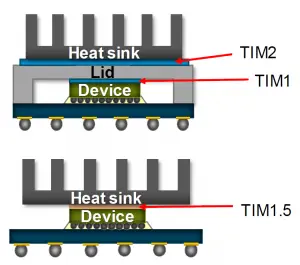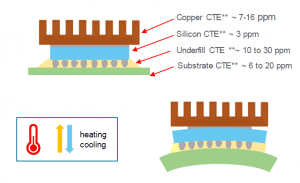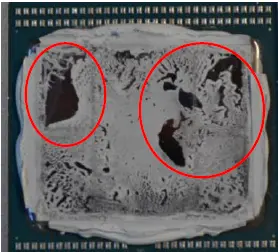Innovative Thermal Management Solutions Clear Way for Rise of Next-Gen Military Technology Authored By:
Rick Johnson, Laird R&F Products
Daniel Ramirez, Laird Performance Materials
Jason Strader, Laird Performance Materials
High-powered radar jamming systems. Hypersonic weapons. Advanced satcom technology. All these innovations strengthen the U.S. military’s warfighting capabilities. But they also create new complex design challenges. Design engineers must address these challenges creatively to ensure reliable performance from the electronics the military relies on to outmaneuver enemies and shield the warfighter.
A pressing challenge today is managing the heat produced within these advanced electronics. To accommodate all the components required to boost performance, systems on chips (SoCs) are getting larger. Chip packages are growing too, but not as quickly. Therefore, the power density within chip packages is increasing significantly as design engineers place more high-powered and heat-generating components within limited real estate on a PCB. This significant increase in power density complicates thermal management.
As they seek to address these complex thermal management challenges, military and aerospace design engineers must also continue to meet the military’s exacting performance standards. The military requires decade-plus-long lifespans for all the components within its technology, so engineers need reliable and proven thermal management solutions. How can military and aerospace design engineers respond to these multifaceted challenges? At a high level, we see three keys to success that we will explore in this article:
- Embrace materials science innovations that enhance the reliability and thermal conductivity of materials.
- Optimize the use of space in packed designs with “integrated” solutions.
- Pursue rigorous modeling and testing to verify the performance of thermal interface materials.
The role of thermal interface materials (TIMs) in the overall performance of these advanced electronics can’t be overstated. TIMs transfer heat between heat-generating components (like a chip on a PCB) and a heat-dissipating source (a heat sink, for instance). They come in different forms, including pads, putties, phase-change materials, thermal greases and thermally conductive insulator materials. Improvements in the material makeup of TIMs will play a crucial role in the military’s ability to handle the increased heat within these advanced electronics and continue to propel forward next-gen technology.
Figure 1: Thermal interface materials transfer heat between heat-generating components and heat-dissipating components.
Conquer Pump Out and Delamination with Joint-Healing Materials
As die sizes increase and heating and cooling cycles grow more intense, flexing of the chip package increases. This flexing can wreak havoc on thermal interface materials. Eventually, this flexing can lead to thermal material “pump out” and compromise the performance of these materials. Further, mismatches between the coefficients of thermal expansion of different parts of a chip package (e.g., the substrate, the heat sink and the thermal interface material) can result in delamination and failure at the edges of thermal interface material. Pump out and delamination destroy the integrity of the thermal path, create hot spots in chip packages and can ultimately lead to device failure. In consumer electronics, this failure might mean a delayed product launch or angry customers. In the military, the stakes are much higher. And as die sizes increase to accommodate more hot components, these problems will worsen.
Figure 2: During heating and cooling cycles, packages can periodically flatten and bend.
Figure 3: Thermal material can “pump out” after heating and cooling cycles.
When it comes to addressing pump out and delamination, traditional thermal interface solutions fall short. Thermal grease will fail in the face of the intense flexing action within chip packages. Highly thixotropic phase-change materials that soften at high temperatures often fail to maintain their integrity, as well. Further, a cured-in-place TIM might break when subjected to the intense flexing of chip packages, compromising the thermal path for good. That’s why materials scientists are devising new thermoplastic-based solutions to address these challenges.
These thermoplastic-based solutions have high “softening” points but importantly never “melt” or change state. Whereas traditional phase-change materials might soften at the operating temperature of a device, these solutions soften at or near the maximum operating temperature of a device. If pushed to that limit, the material will soften but then return to its original state when cooled again. In this way, these materials “self-dam,” warding off pump out. Further, they have joint-healing capabilities. Even if compromised at a joint, these thermoplastic materials “heal” when heated, regaining contact with surfaces and preserving the integrity of the thermal path.
These new, thermoplastic-based joint-healing solutions offer design engineers a way to cope with increased power density, rising heat loads, and the two-pronged challenge of pump out and delamination.
Stand Up to Harsh Conditions
Further, TIMs in military and aerospace applications must perform reliably in the face of harsh and challenging conditions. We’re talking shifts from temperatures as high as 300 degrees Fahrenheit to temperatures as low as -50 degrees Fahrenheit, exposure to jet fuel fumes and deicing fluids, and within high-vacuum environments.
Current innovations in the material makeup and composition of TIMs improve their reliability in these harsh environments. Outgassing is a particularly pressing concern in optical applications since it can blow out lenses and cause device failure. Post-cure processes can minimize outgassing, and materials science innovations are further enhancing the ability of TIMs to resist outgassing.
Another concern for design engineers is that while silicone offers great thermal management benefits, silicone-based TIMs can “bleed” uncrosslinked low molecular weight materials, reducing the adhesiveness of surrounding components or hindering rework of soldered components. Increasingly, there are non-silicone based TIMs that design engineers can use for particularly sensitive applications while materials scientists continue to work to improve the makeup of silicone-based TIMs to make them more stable.
Additionally, in some situations, design engineers may need to insulate a hot component to protect surrounding parts. Innovative thermal insulation solutions, such as high-temperature resin systems loaded with microballoons, can offer effective thermal insulation as well as dielectric properties. So, design engineers can implement a heat barrier that they can transmit signal through.
An important way to ensure components survive harsh conditions is to eliminate moving parts and the need to replace components that fatigue over time. The solution here is passive cooling, meaning no fans or other “active” components that remove heat. Scientists are improving the basic properties of TIMs to minimize thermal resistance and allow more efficient heat transfer in all applications. However, these innovations are especially important in passive cooling applications, where TIMs play a crucial role in ensuring optimal heat transfer. Scientists’ goal in improving TIM properties is to reduce the contact thermal resistance by making TIMs softer and to increase the thermal conductivity. Scientists have used aligned graphite fibers to develop TIM pads that offer thermal conductivity up to 34 W/mK, for example.
Given the harsh conditions military and aerospace components are subjected to, design engineers must look beyond traditional thermal conductivity and insulation solutions. To meet the military’s exacting requirements and build more reliable thermal management solutions, it’s important that they capitalize on the latest innovations.
A Multifunctional Approach for Smaller Spaces
With less room to work within high-powered chip packages, design engineers need thermal management solutions as well as electromagnetic interference (EMI) management solutions that perform reliably without taking up significant space. This means devising solutions that solve multiple problems at once. We call these “integrated” solutions. These solutions address both signal interference and heat. Instead of having to find room for a microwave absorber and a thermal pad, a design engineer can use a single, integrated solution that offers good thermal conductivity as well as EMI absorption capabilities. While chips produce heat that must be transferred and dissipated, they also often produce signal noise. And a heat sink can radiate this noise like an antenna. Integrated thermal transfer and microwave absorber solutions can address these challenges efficiently. For example, modern filler systems enable thermal conductivity up to 12 W/mK while also blocking harmful EMI, resulting in lower temperatures and improved signal integrity.
Multifunctional pads and dispensable materials with enhanced thermal conductivity and EMI absorbing properties are coming on the market and offer design engineers an opportunity to enhance performance without using up more space. These non-silicone thermal pads are also softer than traditional non-silicone pads, minimizing residual stress impact on sensitive components.
Additionally, there are integrated solutions on the market suitable for a wide variety of applications. For example, some are designed to facilitate heat transfer over large gaps and in applications with repeated insertions or relative motion. These compressible gasket solutions can also offer electrical conductivity, using the thermal path as the grounding path for shielding. By helping design engineers address two challenges at once, integrated solutions help them free up space in increasingly crowded chip packages and simplify bills of materials.
Trust, but Verify
Amid the rampant innovation taking place in the industry, design engineers must remain focused on reliability. Therefore, it’s crucial to verify the performance of these innovative materials through advanced testing.
Reliability testing varies from application to application. However, in general, functionalized polymer composites such as TIMs or absorbers are subjected to environmental conditions harsher than the applications in which they will be used. This approach accelerates aging of the materials and helps scientists assess the lifetime performance of the materials. Testing can include subjecting these materials to high-temperature bakes of at least 30 degrees Celsius above the operating temperature for, in many cases, 2,000 hours or more.
Other conditions include highly accelerated stress tests (HAST) and temperature cycling/shock. For many electronics, these stress tests are run at 85 C and 85% relative humidity for anywhere from 72 hours to more than 2,000 hours. Temperature cycling/shock can take place at temperatures as low as -60 C and up to 125 C for 1,000-2,000 cycles (or more). This rigorous testing helps scientists evaluate materials and determine how reliable the materials will be and how long they will last in different applications.
But this testing often isn’t enough. Given the increased complexity of military electronic design and the unique environments in which military electronics must operate, engineers must go beyond standard thermal and EMI testing and engage in customized application testing. This customized approach helps engineers ensure advanced electronics perform under mechanical shock and vibe, thermal cycling and the full range of EMI challenges that could affect them over their life cycles.
Rethinking Thermal Management for Next-Gen Military Technology
As technology advances rapidly in the military and aerospace industries, thermal management solutions must keep pace. Fortunately for design engineers, materials scientists are pushing the envelope on innovation and devising thermal interface solutions that meet the reliability requirements of the military and address the complex challenges that threaten electronic device operability.
To capitalize on these innovations, engineers must challenge their traditional design processes. The days of solving signal and heat issues separately – and late – in the design process are over. Instead, design engineers must adopt a system-level approach to design. Consider the EMI and thermal implications of all design decisions and preemptively address them. This advanced planning will help design engineers devise the most creative and effective solutions – and make the most of limited space within chip packages.
Advancements in electronic warfare promise to improve the U.S. military’s warfighting ability. But challenges accompany these innovations. Fortunately, as challenges mount, materials science is coming to the rescue. Design engineers must recognize the thermal management innovations happening in the industry and adjust their processes to ensure they capitalize on these innovations and continue to clear the way for ongoing military and aerospace technological advancements.
About the Authors

Aerospace and Defense Director, Laird R&F Products

Field Application and Technical Support Engineer, Laird Performance Materials

Director of Technology, Laird Performance Materials









